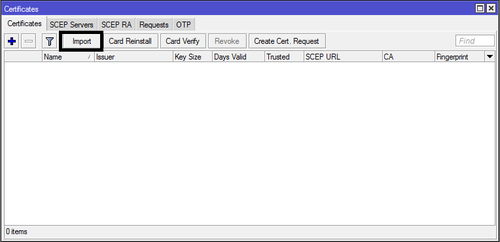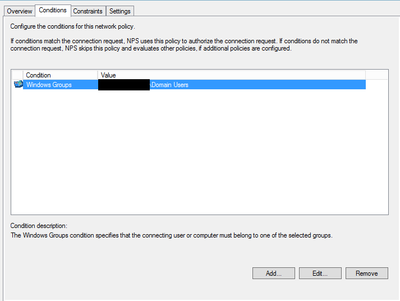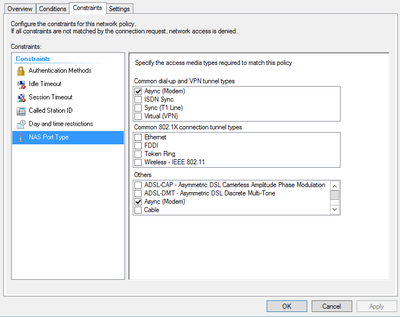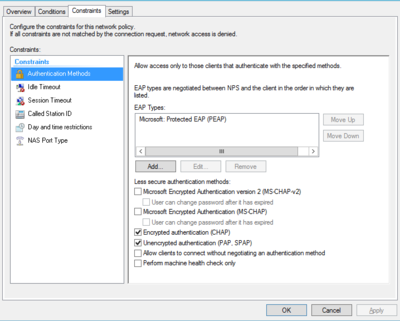RouterOS OpenVPN
RouterOS support OpenVPN server and client. OpenVPN is one mostly secure VPN tunnel protocol.
Sisällysluettelo
Server
This manual shows, how to configure Mikrotik OpenVPN Server.
Requirements / Recommendation =
- SSL Root Certificate (CA)
- SSL Server Certificate
- SSL Client Certificate
- Tested Mikrotik RB951G-2HnD and RouterOS 6.26
How to
1. Create SSL certificate first, example OpenSSL and move certificate to Mikrotik with Winbox.
Import Certificate key and certificate to RouterOS.
/certificates import file-name=ssl.key
/certificates import file-name=ssl.crt
2. Create DHCP Pool (if you want use bridge, you can skip this step)
/ip pool add name=ovpn-pool ranges=10.15.32.34-10.15.32.38
- DHCP pool name is ovpn-pool
- Pool area is 10.15.32.34-10.15.32.38
3. Create routing OpenVPN network to local network (if you want use bridge mode, you can skip this step)
/ip firewall nat add chain=srcnat out-interface=ether2 action=masquerade
Create NAT to ether2 interface
4. Create OpenVPN Profile
/ppp profile add name=openvpn local-address=10.15.32.33 remote-address=ovpn-pool
- Profile name is openvpn
- Local IP-address is 10.15.32.33
- VPN customer get remote IP-address from ovpn - DHCP pool.
- Using bridge, please remove local-address and remote address. Add bridge, example bridge-local
/ppp profile add name=openvpn_bridge bridge=bridge-local
5. Create VPN user
/ppp secret add disabled=no name="openvpn" password="Qwerty1" service=any
- Username: openvpn
- Password: Qwerty1
- Service what can use this user: Openvpn
6. OpenVPN server configuration
/interface ovpn-server server set auth=sha1, certificate=ssl_cert cipher=aes128,aes256 default-profile=openvpn enabled=yes keepalive-timeout=60 max-mtu=1500 mode=ip netmask=29 port=1194 require client-certificate=no
- Authentication: SHA1
- SS Certificate: ssl-cert
- SSL Chipper: AES128, AES256
- Default Profile: openvpn
- Keepalive-timeout=60
- MAX-MTU (packet size): 1500
- mode=ip (if you use bridge mode, change this to ethernet)
- require client-certificate=no (if you use client certificate, change value to yes)
6. Enable access from firewall
/ip firewall filter add action=accept chain=input comment="OpenVPN" disabled=no dst-port=1194 protocol=tcp
Create new firewall rule what accept protocol TCP port 1194
Radius
- Lisää Mikrotikkiin Radius palvelimesi asetukset /radius alle.
- Määritä palvelimelle sallituksi todennustyypit CHAP / PAP, SPAP
- Määritä NAS Port tyypiksi Async.
/radius add service=ppp address=10.0.0.254 secret=securepassu authentication-port=1812 accounting-port=1813
Esimerkki konfiguraatiot Windows NPS palvelimelta.
Client
RouterOS
OpenVPN client can connect to OpenVPN server.
1. Create OpenVPN client profile to client device.
/ppp profile add name=openvpn-client
2. Create new OpenVPN client:
/interface ovpn-client name="openvpn-client" connect-to="server.openvpn.com" port="1194" mode="ip" user="openvpn" password="openvpn123" profile="openvpn-client" certificate="no" auth="sha1" cipher="aes128" add-default-route="no"
- name = connection name
- connect-to = OpenVPN Server address or IP-address
- port = OpenVPN Server port what server listen
- mode = ip (ethernet, if you use bridge mode on VPN server)
- user = OpenVPN user
- password = OpenVPN user password
- profile = Profile what OpenVPN use
- certificate = SSL client certificate
- add-default-route = Add this VPN to default route?
3. Try connect and watch log if connection not working.
Linux
Esimerkki konfiguraatio client.ovpn:
client dev tun #Voi olla tap. Tun on reitittävä ja tap on siltaava. Katso että vastaa palvelimen konfiguraatiota. proto tcp #Tai udp, RouterOS ei tue UDP:nä. resolv-retry infinite nobind remote vpn.example.org 1194 # Etä OpenVPN palvelimen osoite tai IP-osoite sekä portti #Lisää tähän rootCA jonka olet luonut, avaa se ja kopioi sisältö <ca> -----BEGIN CERTIFICATE----- -----END CERTIFICATE----- </ca> #Lisää tähän asiakas sertifikaatin jonka olet luonut. <cert> -----BEGIN CERTIFICATE----- -----END CERTIFICATE----- </cert> #Lisää tähän asiakkaan sertifikaatin privaatti avaimen. <key> -----BEGIN PRIVATE KEY----- -----END PRIVATE KEY----- </key> tls-client port 1194 #Portti jota palvelin kuuntelee user nobody group nogroup #comp-lzo # Do not use compression. It doesn't work with RouterOS (at least up to RouterOS 3.0rc9) # More reliable detection when a system loses its connection. ping 15 ping-restart 10 ping-timer-rem persist-tun persist-key # Silence the output of replay warnings, which are a common false # alarm on WiFi networks. This option preserves the security of # the replay protection code without the verbosity associated with # warnings about duplicate packets. mute-replay-warnings # Verbosity level. # 0 = quiet, 1 = mostly quiet, 3 = medium output, 9 = verbose verb 3 cipher AES-256-CBC auth SHA1 pull route-nopull #Verkot jotka reititetään VPN verkkoon route 192.168.1.0 255.255.255.0 push "dhcp-option DNS 8.8.8.8" #DNS palvelin jota käytetään #redirect-gateway def1 #Haluatko reitittää kaikki VPN kautta? Ota tästä risuaita pois #Salasana tiedosto auth-user-pass auth.cfg
auth.cfg tiedoston tulisi sisältää käyttäjänimen (username) ja salasananan (password)
username password



